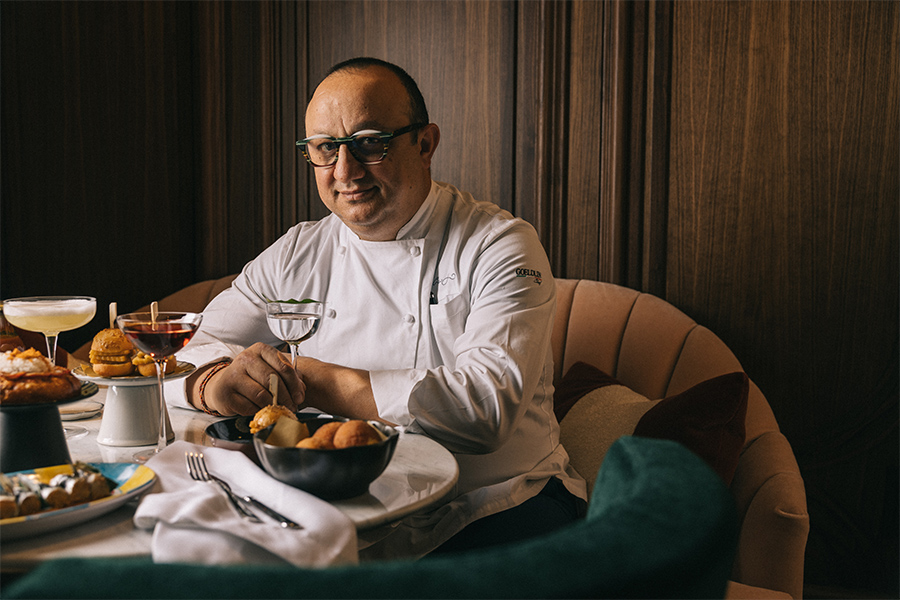Wolfram Putz, Thomas Willemeit, and Lars Krückeberg met as students at TU Braunschweig in Germany and quickly learned they shared common interests in art, philosophy, music, and exploring nature. “We all came to realize that architecture can combine all of them,” says Krückeberg. Enter Graft, established in Los Angeles in 1998, a studio that explores how to “combine assumed opposites and create a synthesis to resolve complex problems,” says Putz. Now, the firm boasts two additional offices in Berlin and Beijing and employs around 130 people—architects, engineers, artists, and creatives from some 30 countries working across interiors, products, architecture, and masterplanning, anything “as long as it merits a creative journey and can have an impact on society,” says Willemeit, adding that they embed a multifaceted and complex cultural discussion into all their projects. “We do not specialize in specific typologies or a certain type of client since we strongly believe that good architecture is not a First World privilege.” Along with their robust portfolio, the trio recently released Architecture Activism, their book that documents 10 projects that address problems like disaster relief and gentrification. Here, the founders sound off on designing for pure fun, empowering off-grid communities, and breaking down walls.
Tell us about your work with Solarkiosk in Africa, which focuses on off-grid communities?
Lars Krückeberg: It addresses the approximately 16 percent of the world’s population for whom most social and economic activity effectively ceases at nightfall—1.5 billion people worldwide have to live without electricity, 600 million in Africa alone. These off-grid households spend on average 40 percent of their entire income on alternative, nonsustainable sources of power, such as kerosene, diesel generators, charcoal, and dry cell batteries—a significant hazard for health and the environment. Africa is still the fastest-growing market for telecommunications, with millions of new subscriptions every year. Mobile phones are everywhere, but energy is not. To have any chance to participate in the world’s future development, remote communities need a reliable, affordable, and clean source of energy.
Along with our partner [Solarkiosk CEO and cofounder] Andreas Spiess, we have built an infrastructure instrument [called E-Hubbs, with a modular kit-of-parts design] that can create an impact from the bottom up, cooperating directly with local people and developing their community. With clean solar energy and an inclusive business model, Solarkiosk provides an energy supply, connectivity, and communication even in remote regions. It gives local people the opportunity to acquire new skills and gain economic stability to safeguard their health and the environment, and to gain direct access to global markets without censorship or financial control by governments or corporations.
With the mixed-use Eckwerk project in Berlin, how are you trying to push the idea of urban living?
Wolfram Putz: Eckwerk is a very ambitious project dealing with those gentrification processes that have brought transformations to cities worldwide: rising property values trigger the loss of affordable housing and social diversity in central districts, leading to a decline in urban vitality. We teamed up with [Germany and Oslo, Norway-based] architecture firm Kleihues+Kleihues to develop affordable housing in a collaborative design development that challenges the status quo in central Berlin.
What did you want to create with Rose Square, one of the few public spaces in Tbilisi, Georgia?
Thomas Willemeit: It is a unique spot due to its urban setting between the Radisson Blu Iveria and the Radisson Telegraph to the north with an open view toward the city. At the moment, it is only an in-between space used as a parking area. For the new square, we developed a design that reflects the distinct features of Tbilisi’s terraced topography and reanimates so far unused potentials of the area. We designed a folded surface, floating above the ground. It hovers over the city center connecting different levels and areas. The new space will connect the square to the underground and offers new retail and restaurant areas, as well as sunken gardens.
Why did you take on Apassionata, a 12-acre horse-themed adventure park in Munich that features interactive pavilions and a central show palace?
LK: We worked a lot in Las Vegas where most concepts are based on strong narratives, [it being] the biggest and most successful adventure park that exists. When we were asked to develop the [converged infrastructure] and aesthetical DNA for Apassionata, it was not something new for us. It is a wonderful task to develop a little world with its own rituals, atmospheres, and materiality. And to design a theater specifically shaped by narrative possibilities around horses was just pure fun.
How did the modular, changeable façade for the Urban Nation Museum in Berlin come about?
TW: The design was a conundrum: How do you define a space for art that wants to be in the street as an urban phenomenon and not in a museum? So we designed a museum within a very normal urban setting of a 19th-century residential block and contrasted it with unconventional interventions. Urban art does not need a white cube; it is seeking its own place. We also had to extend the street into the house and connect it to the city. We had to break with the expectation of what a museum is: all surfaces of the museum can be painted and worked on, including the façade. What is different is that there are subtle hanging systems so that the art, which usually is temporary, can be collected.
LK: More importantly, the museum becomes an urban agent itself in a difficult low-income area of the city, as it interacts with the community’s youth and gives them a platform to express themselves together with the heroes of the urban art scene.
How are you integrating sustainability and wellness into the Six Senses Resort Gammarth in North Africa’s Tunisia?
LK: There will be the magic of water, air, and sound blended into great experiences through treatments and specifically shaped spaces. The architecture will ground you, meaning it will reflect the beauty around you and is shaped by it. Nature, wind, and water dynamics generate very specific geometries when meeting with sand. We designed the hotel with exactly that DNA of sand dunes and ripples to make the customer an integrated part of the place and dynamics. We understand architecture much like the organism of our bodies. The same rules of wellness and sustainability apply: healthy materials, process to growth, and harmony within your context and system. This is not about a specific sustainability certification, but about understanding your local environment and guiding its potential into a synthesis, into something new.
You also recently completed wellness and spa resort Seezeit Lodge at Lake Bostalsee in the south of Germany.
LK: The design for the hotel draws significantly from the unique natural setting of a peninsula located between a forest and a serene lake. The experience of both natural characters is enhanced through the architecture as it guides the guest through the shaped landscape into the airiness of the lake views. In accordance with this idea, the building figure develops out of the topographical gestalt with a wooden façade hovering above. We inscribed geometries framing the local sunsets at the equinoxes and solstices, as the main narrative seeks to connect the guests experience with the local forces and phenomena, forming new rituals of awareness and leisure.
What is next in terms of sustainability in both living and hospitality spaces?
TW: Lean tech cars and automated driving will change our building codes, as we will have [a significant reduction in] air and noise pollution, and we will gain our cities back as [fewer cars on the road with] smart sensors [will make streets safer]. All this needs digitalization and of course, hopefully, clean energy, which already is our secret common currency, as everything can be broken down to energy costs. Hospitality will be developing along these lines. In rural areas, resorts can play a meaningful role and have a huge impact on local communities. In this sense, we think the super local hotel will be a success story of the future.
What do industries need to do to further the sustainability conversation?
WP: The way we produce and consume things needs to change, along the lines of cradle-to-cradle designs. That means all products and technologies are considered as nutrition or a resource that goes back into the flow of production once it is not used anymore. Just like nature, there would be no waste. And it can be done without finger-pointing and asceticism. This is an ongoing conversation with important dynamics to unfold.
What else are you working on?
LK: We are designing the German Pavilion of next year’s Venice Architecture Biennale. The theme is Unbuilding Walls. The Berlin Wall stood for 28 years, and it will be gone for 28 years in 2018. We are taking this mirror effect to look at urban implications of division and inclusion, especially in times where new walls are proposed and built again all over the world.
Any dream projects?
LK: Where to begin: a mountain resort, a landscape garden, a floating refugee university island, a football stadium, a Silk Road caravanserai 2.0, a classical music hall. Life will be too short, that
is certain.


